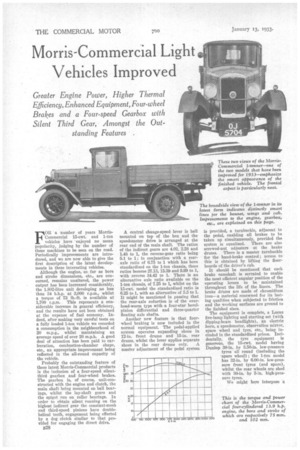Morris-Commercial Ligh Vehicles Improved
Page 42

Page 43

If you've noticed an error in this article please click here to report it so we can fix it.
FOR a number of years Morris.. Commercial 15-cwt. and 1-ton vehicles have enjoyed no mean popularity, judging by the number of these machines to be seen on the road. Periodically improvements are introduced, and we are flaw able to give the first description of the latest developments in these interesting vehicles.
Although the engine, so far as bore and stroke dimensions, etc., are concerned, remains unaltered, the power output has been increased considerably, the 1.802-litre unit developing no less than 34 b.h.p. at 3,000 r.p.m., whilst a torque of 73 lb.-ft. is available at 1,700 r.p.m. This represents a considerable increase in general efficiency, and the results have not been obtained at the expense of fuel economy. Indeed, after making very careful tests on a fully loaded 1-tun vehicle we recorded a consumption in the neighbourhood of 20 m.p.g., whilst maintaining an average speed of over 20 m.p.h. A good deal of attention has been paid to carburation, combustion-chamber shape, etc., an appropriate improvement being reflected in the all-round capacity of the vehicle.
Probably the outstanding feature of these latest Morris-Commercial products is the inclusion of a four-speed silentthird gearbox and four-wheel brakes. The gearbox is, of course, unit-constructed with the engine and clutch, the main shaft being mounted on ball bearings, whilst the lay-shaft gears and the spigot run on roller bearings. In order to obtain silent running on the highest indirect gear the constant-mesh and third-speed pinions have doublehelical teeth, engagement being effected by a dog clutch similar to that provided for engaging the direct drive.
B28 A central change-speed lever is ball mounted on top of the box and the speedometer drive is arranged at the rear end of the main shaft. The ratios of the indirect gears are 4.02, 2.28 and 1.48 to 1, the reverse-gear ratio being 5.1 to 1; in conjunction with a rearaxle ratio of 6.75 to 1 which has been standardized on the 1-ton chassis these ratios become 27.13, 15.39 and 9.99 to 1, with reverse 34.42 to 1. There is an alternative axle ratio available on the 1-ton chassis, of 7.25 to 1, whilst on the 15-cwt. model the standardized ratio is 6.25 to 1, with an alternative of 5.5 to 1. It might be mentioned in passing that the rear-axle reduction is of the overhead-worm type with a four-star bevelpinion differential and three-quarter floating axle shafts.
Another new feature is that fourwheel braking is now included in the normal equipment. The pedal-applied system operates expanding shoes in 12-in, front drums and 15-in, rear drums, whilst the lever applies separate shoes in the rear drums only. A master adjustment of the pedal system is provided, a turnbuckle, adjacent to the pedal, enabling all brakes to be taken up simultaneously, provided the system is equalized. There are also screwed-nut adjusters at the brake drums. There is a master turnbuckle for the hand-brake control; access to this is obtained by lifting the floorboards of the driver's cab.
It should be mentioned that each brake camshaft is serrated to enable the most efficient angular position of the operating levers to be maintained throughout the life of the liners. The brake drums are made of chromidium iron—a material renowned for its lasting qualities when subjected to friction and the working surfaces are ground to the finished sizes.
The equipment is complete, a Lucas five-lamp lighting and starting set (with dipping-beam headlights), an electric horn, a speedometer, observation mirror, spare wheel and tyre, etc., being inchided in the standardized prices. Incidentally, the tyre equipment is generous, the 15-cwt. model having Dunlop 30-in. by 5.50-in, low-pressure tyres all round (including the rspare wheel) ; the 1-tan model has 32-in. by 6.00-in, low-pressure front tyres (and spare), whilst the rear wheels are shod with 30-in. by 5-in. high-pressure tyres.
We might here interpose a few remarks regarding the models and prices. Although many features are common to both the 15-cwt. and the 1-ton types, the smaller-capacity vehicle is built with a shorter chassis than the 1-tonner, the Wheelbase dimensions being respectively 9 ft. 6 ins. and 10 ft. 2 ins. ; the wheel track is 4 ft. 8 ins. in each case. Again, in the matter of overall length, the 1-ton chassis is some 9 ins. longer than the 15-cwt. model, the latter measuring 12 ft. 10i. ins.
Turning, now, to freight capacity, the 15-cwt. van has a pay-load space of 100 cubic ft., whilst the larger vehicle has a capacity of 140 cubic ft., the difference being made up almost entirely in the length. On the standard lorry, however, the difference is not so marked, as the platform measures 7 ft. 6 its. by 5 ft. 6 ins, in the case of the larger model, and 7 ft. by 5 ft. 6 ins. in the smaller model, the loading height of the 1-tonner being 3 ft. 7 ins, and the overall length 16 ft. 3 ins. The improvements outlined above are all contained in the standardized specification and have not called for any increase in prices, the 1-ton lorry selling for 1198 complete, whilst the van is priced at £212. For the smaller model the prices stand at respectively £191 and £195.
In the course of a few weeks we shall publish a complete road-test report of the 1-ton lorry-carried out under our standard and fully representative conditions, with complete data relating to performance.




























































































